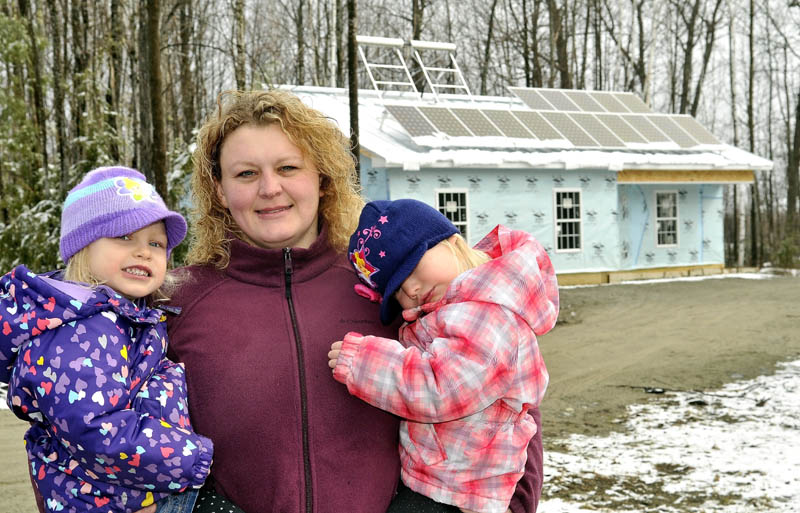OAKLAND — New England’s first solar-powered Habitat for Humanity home will be completed in Oakland this season.
It will be the fourth home built since 2001 by the Waterville area chapter of Habitat for Humanity, an organization that leverages donations and connections to build homes for those who wouldn’t qualify for a traditional mortgage.
Chapter president Mike Grant, 62, said the organization “kind of hit a sweet spot” by taking advantage of state and federal tax credits that made it financially possible to install photovoltaic panels and a solar-powered hot water system.
The solar energy systems will provide 80 percent of the energy needed to heat water and 90 percent of the electricity needs of the home, and are expected to pay for themselves in five years, Grant said.
The cost of the systems is about 15 percent of the $80,000 total value of the home, he said.
The average homeowner, he said, probably would pay more for the system, because habitat was able to make use of free labor and discounted rates.
He said the purpose was to bring down the ongoing energy costs for the homeowner, who assumes a long-term mortgage for the home.
In addition to the active solar features, the house also has been designed and positioned to take advantage of the sun’s warmth, a passive solar feature that will help to reduce the propane-fueled heating costs.
“Heating is a large part of every household’s budget in this part of the world,” Grant said.
He said the systems also were designed to be user-friendly for a first-time homeowner.
“Ease of maintenance is part of our design,” he said. “She’s not even going to know that it’s up on the roof.” Even in the winter, he said, the snow is expected to slide off of the panels.
The home, on Jacques Lane in Oakland, will be a welcome relief for Joni Sprague, a 31-year-old single mother who is now shares a bedroom with her twin, 3-year-old girls.
Sprague, who teaches preschool at Educare in Waterville, said her current two-bedroom apartment, for which she pays $785 a month, is nice, but it just isn’t big enough for her, the girls and Sprague’s mother, who is in her 50s.
For Sprague, the choice to go solar was an easy one. She said it will add about $60 per month to her estimated $600 mortgage payments, but will save her an estimated $100 per month in electricity bills, for a net monthly gain.
Sprague, who was chosen from a pool of about a dozen applicants, has worked alongside Habitat volunteers almost every weekend on the house, putting in required “sweat equity.”
In order to qualify, she had to demonstrate that she had a need, good credit and the ability to pay back a mortgage.
Sprague said she never has been able to qualify for a traditional home loan.
“I looked years ago when I had two jobs and no children,” she said. “I was almost approved, but I had some debt. Now I have one job and two children. Mathematically, it just wouldn’t work.”
Sprague said that the solar system had sparked other environmental plans for her family.
“I have a new interest,” she said. “I want to teach my children to take care of the planet and recycle and compost now.”
While the solar industry in the United States remains relatively small — less than 1 percent of the total electricity produced by power companies — it is growing, and the cost of units is getting smaller, according to statistics from the U.S. Energy Information Administration.
Industry growth is substantial, with U.S. companies shipping 43 percent more photovoltaic modules in 2011, the most recent year on record, than 2010.
Over the past several years, the average price of photovoltaic cells per peak watt has decreased dramatically, from a 2008 high of $2 to 92 cents in 2011.
“The costs of the systems are coming down all the time,” Grant said. “As the technology gets better, the panels get more advanced, so that you can collect more solar energy out of them for a lower cost.”
Grant said the group plans to complete construction in time for an open house in early June.
It’s unclear whether the switch to solar represents a new trend for Habitat for Humanity.
Grant said that future Habitat building projects might include solar features, but it’s not a foregone conclusion. He said it would depend on the costs at the time, and whether the next location has enough sun exposure.
Matt Hongoltz-Hetling — 861-9287
mhhetling@centralmaine.com
Send questions/comments to the editors.



Success. Please wait for the page to reload. If the page does not reload within 5 seconds, please refresh the page.
Enter your email and password to access comments.
Hi, to comment on stories you must . This profile is in addition to your subscription and website login.
Already have a commenting profile? .
Invalid username/password.
Please check your email to confirm and complete your registration.
Only subscribers are eligible to post comments. Please subscribe or login first for digital access. Here’s why.
Use the form below to reset your password. When you've submitted your account email, we will send an email with a reset code.